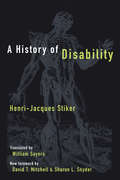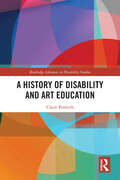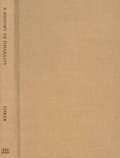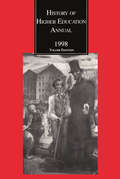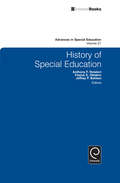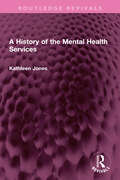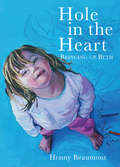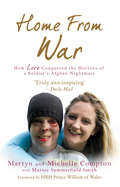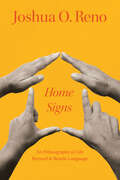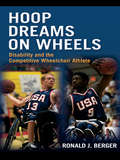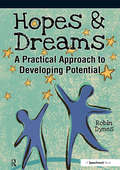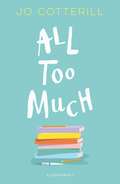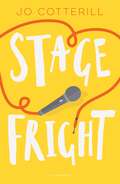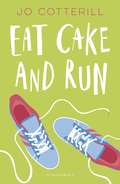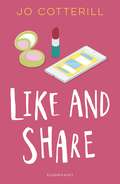- Table View
- List View
A Historical Sociology of Disability: Human Validity and Invalidity from Antiquity to Early Modernity (Routledge Advances in Disability Studies)
by Bill HughesCovering the period from Antiquity to Early Modernity, A Historical Sociology of Disability argues that disabled people have been treated in Western society as good to mistreat and – with the rise of Christianity – good to be good to. It examines the place and role of disabled people in the moral economy of the successive cultures that have constituted ‘Western civilisation’. This book is the story of disability as it is imagined and re-imagined through the cultural lens of ableism. It is a story of invalidation; of the material habituations of culture and moral sentiment that paint pictures of disability as ‘what not to be’. The author examines the forces of moral regulation that fall violently in behind the dehumanising, ontological fait accompli of disability invalidation, and explores the ways in which the normate community conceived of, narrated and acted in relation to disability. A Historical Sociology of Disability will be of interest to all scholars, students and activists working in the field of Disability Studies, as well as sociology, education, philosophy, theology and history. It will appeal to anyone who is interested in the past, present and future of the ‘last civil rights movement’.
A History of Disability (Corporealities: Discourses Of Disability)
by Henri-Jacques StikerThe first book to attempt to provide a framework for analyzing disability through the ages, Henri-Jacques Stiker's now classic A History of Disability traces the history of western cultural responses to disability, from ancient times to the present. The sweep of the volume is broad; from a rereading and reinterpretation of the Oedipus myth to legislation regarding disability, Stiker proposes an analytical history that demonstrates how societies reveal themselves through their attitudes towards disability in unexpected ways. Through this history, Stiker examines a fundamental issue in contemporary Western discourse on disability: the cultural assumption that equality/sameness/similarity is always desired by those in society. He highlights the consequences of such a mindset, illustrating the intolerance of diversity and individualism that arises from placing such importance on equality. Working against this thinking, Stiker argues that difference is not only acceptable, but that it is desirable, and necessary. This new edition of the classic volume features a new foreword by David T. Mitchell and Sharon L. Snyder that assesses the impact of Stiker’s history on Disability Studies and beyond, twenty years after the book’s translation into English. The book will be of interest to scholars of disability, historians, social scientists, cultural anthropologists, and those who are intrigued by the role that culture plays in the development of language and thought surrounding people with disabilities.
A History of Disability and Art Education (Routledge Advances in Disability Studies)
by Claire PenkethDrawing on recent theoretical frameworks from critical disability studies and art education including normalcy, ableism, disability and Crip theory, this book offers an analysis of the conceptualisation of ability in art education and its relationship with disability. Drawing on the work of Cizek and Lowenfeld in Austria, Ruskin and Richardson in England and Dewey and Eisner in the United States, it critically examines the influence of ideas such as the dominance of vision and visuality; the emergence of psychological perspectives; the Child Art Movement; the implications of assessment regimes; and the relevance of art education as a critical social practice on the production of disability. Offering a sustained inquiry into the differential values attributed to learners and their work and the implications of this for framing our understanding of disability in art education, this book shows that although art educators have frequently advocated for the universal appeal and importance of art education, they have done so within historical contexts that have produced and determined problematic ideas regarding disability. It will be of interest to all scholars and students of disability studies, art in education, art history and education studies.
A History of Disability and Art Education (Routledge Advances in Disability Studies)
by Claire PenkethDrawing on recent theoretical frameworks from critical disability studies and art education including normalcy, ableism, disability and Crip theory, this book offers an analysis of the conceptualisation of ability in art education and its relationship with disability. Drawing on the work of Cizek and Lowenfeld in Austria, Ruskin and Richardson in England and Dewey and Eisner in the United States, it critically examines the influence of ideas such as the dominance of vision and visuality; the emergence of psychological perspectives; the Child Art Movement; the implications of assessment regimes; and the relevance of art education as a critical social practice on the production of disability. Offering a sustained inquiry into the differential values attributed to learners and their work and the implications of this for framing our understanding of disability in art education, this book shows that although art educators have frequently advocated for the universal appeal and importance of art education, they have done so within historical contexts that have produced and determined problematic ideas regarding disability. It will be of interest to all scholars and students of disability studies, art in education, art history and education studies.
A History Of Disability (PDF)
by Henri-Jacques Stiker William SayersThe increasing numbers of scholars, policy-makers, and political activists who are concerned with questions of physical and cognitive disability will warmly welcome Henri-Jacques Stiker's book, the first to attempt to provide a framework for analyzing disability through the ages. Published in 1997 in France as Corps infirmes et soci#65533;t#65533;s and available now in an excellent English translation, the book traces the history of western cultural responses to disability, from ancient times to the present. In this volume, Stiker examines a fundamental issue in contemporary Western discourse on disability: the cultural assumption that equality/sameness/similarity is always desired by those in society. He highlights the consequences of such a mindset, illustrating the intolerance of diversity and individualism that arises from placing such importance on equality. Importantly, Stiker does not hesitate to assert his own stance on the issues he discusses: that difference is not only acceptable, but that it is desirable, that it is necessary. The author goes beyond anecdotal history to traverse a little known history, penetrating to the heart of collective attitudes and reflecting on elements of policy. The sweep is broad; from a rereading and reinterpretation of the Oedipus myth to current legislation regarding disablity, he proposes an analytical history that demonstrates how societies reveal themselves through their attitudes towards disability, at times in unexpected ways, since the study of detail is often the best entry into the whole of a culture. The book will be of interest to scholars of disability, historians, social scientists, cultural anthropologists, and those who are intrigued by the role that culture plays in the development of language and thought surrounding the disabled. Henri-Jacques Stiker is Director of Research and member of the department of the History and Civilization of Western Societies, University of Paris VII. 9780472086269
History of Higher Education Annual: The Land-Grant ACT and American Higher Education: Contexts and Consequences
by Roger L. GeigerPublished in 1998, this is Volume 18 of the Perspectives on the History of Higher Education annual which includes a collection of 7 articles on The Land-Grant Act and American Higher Education: Context and Consequences.
History of Higher Education Annual: The Land-Grant ACT and American Higher Education: Contexts and Consequences (History Of Higher Education Annual Ser.)
by Roger L. GeigerPublished in 1998, this is Volume 18 of the Perspectives on the History of Higher Education annual which includes a collection of 7 articles on The Land-Grant Act and American Higher Education: Context and Consequences.
History of Special Education (Advances in Special Education #21)
by Anthony F. Rotatori Festus E. Obiakor Jeffrey P. BakkenThis volume will examine the history of special education by categorical areas (e.g., Learning Disabilities, Mental Retardation, and Autistic Spectrum Disorders). Each categorical area chapter will include an examination of: changing definitions, early pioneers in the field, major contributors and their theoretical ideas, changing educational and treatment practices, working with families, the use of technology, assessment practices and legislative acts specific to that categorical area. The volume will also include chapters on the changing philosophy related to educating students with exceptionalities as well as a detailed history of legal and legislation content concerned with special education. The volume will provide readers with a unique perspective on why special education is what it is today.
A History of the Mental Health Services (Routledge Revivals)
by Kathleen JonesFirst published in 1972, A History of the Mental Health Services is a revised and abridged version of both Lunacy, Law and Conscience and Mental Health and Social Policy, rewriting the material from the end of the Second World War to the passing of the Mental Health Act 1959, and adding a new section which runs from 1959 to the Social Services Act 1970. The story starts with the first legislative mention of the ‘furiously and dangerously mad’ as a class for whom some treatment should be provided, traces the development of reform and experiment in the nineteenth century, and the creation of the asylum system, and ends in the age of Goffman and Laing and Szasz with the virtual disappearance of the system. The book will be of interest to students of mental health, sociology, social policy, health policy and law.
A History of the Mental Health Services (Routledge Revivals)
by Kathleen JonesFirst published in 1972, A History of the Mental Health Services is a revised and abridged version of both Lunacy, Law and Conscience and Mental Health and Social Policy, rewriting the material from the end of the Second World War to the passing of the Mental Health Act 1959, and adding a new section which runs from 1959 to the Social Services Act 1970. The story starts with the first legislative mention of the ‘furiously and dangerously mad’ as a class for whom some treatment should be provided, traces the development of reform and experiment in the nineteenth century, and the creation of the asylum system, and ends in the age of Goffman and Laing and Szasz with the virtual disappearance of the system. The book will be of interest to students of mental health, sociology, social policy, health policy and law.
Hole in the Heart: Bringing Up Beth
by Henny Beaumont'Wonderful, astonishing drawings... A masterclass in the sorrow and joy of being human, and a powerful reminder that nothing is more earth-shattering than love.’—Meg RosoffThe mother of a daughter with Down's Syndrome shares her family's journey—in beautiful black and white drawings—from hospital to home, and from early years to school, in this moving, wise and unsparing graphic memoir.On Mother’s Day 2001 Henny Beaumont gave birth to her third child. For the first four hours, her baby seemed no different from her two other little girls.When the registrar told Henny and her husband that their daughter might have Down’s Syndrome, she thought that her life was over. How would she be able to look after this baby, who might die, and manage her other two children at the same time? How could this weak little baby, who needed so much more from Henny than her other two children, provoke such feelings of hatred and resentment? And how would she learn to love her? If she can’t trust her own reactions to Beth, how could she expect other people to overcome their prejudices and ignorance about her condition?Hole in the Heartis a moving, funny, ironic and refreshingly honest look at living with a child who has special needs. Henny’s remarkable journey speaks not only to parents who have had a similar experience and the medical and care professionals who try to help them, but to every one of us who feels anxiety about our children – wondering whether they are achieving enough, whether we do enough for them, and whether we love them enough.As the PE teacher asks: ‘Who’s really got the special needs here?’
Home From War: How Love Conquered the Horrors of a Soldier's Afghan Nightmare
by Marnie Summerfield Smith Martyn Compton Michelle ComptonLance Corporal Martyn Compton's life was changed beyond recognition when he was blown up in a Taliban ambush that killed three of his colleagues. His survival was described as a 'miracle', as he suffered third-degree burns to 75 per cent of his body. He endured 15 operations and doctors used shark cartilage as a base for new skin on his face.But he did not have to face this gruelling ordeal alone. From the moment she heard of his near-fatal wounds, Martyn's fiancée Michelle Clifford found an inner strength to help them both face the future. During Martyn's treatment, Michelle kept a diary in which she revealed the innermost thoughts and emotions she wished she could relay to her wounded partner.Home From War gives a rare insight into the story behind the headlines when soldiers die or are injured. It is also the account of Martyn's battle for adequate compensation. This exploration of how one courageous man came to terms with losing his handsome young face cannot fail to inspire.
Home Signs: An Ethnography of Life beyond and beside Language
by Joshua O. RenoAn intimate account of an anthropologist’s relationship with his non-verbal son and how it has shaped and transformed his understanding of closeness and communication. Home Signs grew out of the anthropologist Joshua Reno’s experience of caring for and trying to communicate with his teenage son, Charlie, who cannot speak. To manage interactions with others, Charlie uses what are known as “home signs,” gestures developed to meet his need for expression, ranging from the wiggle of a finger to a subtle sideways glance. Though he is nonverbal, he is far from silent: in fact, he is in constant communication with others. In this intimate reflection on language, disability, and togetherness, the author invites us into his and Charlie’s shared world. Combining portraits of family life and interviews with other caregivers, Reno upends several assumptions, especially the idea that people who seem not to be able to speak for themselves need others to speak on their behalf. With its broad exploration of nonverbal communication in both human and nonhuman contexts, Home Signs challenges us to think harder about what it means to lead a “normal” life and to connect with another person.
Homespun Remedies: Strategies in the Home and Community for Children with Autism Spectrum and Other Disorders (PDF)
by Dion Betts Nancy J Patrick`Written by professionals, who also have personal experience of living with a child with special needs, this book offers solutions to specific difficulties commonly experienced by children with Autistic Spectrum Disorder (ASD). From hair cuts to homework, the solutions offered revolve around core principles of providing predictability and structure whilst utilizing visual prompts where possible.' - youthinmind.co.uk `Homespun remedies is a useful source of reference for anyone living or working with a child with ASD. It is presented in a practical and easy reading style, on a topic that can be complex and very difficult to understand at times. Some of the common daily problems facing children with ASDs are touched on in a clear and simple manner and parents may find comfort and reassurance in reading other parents' experiences of these.' -The Frontline of Learning Disability, Autumn 2006 `The book has an easy-to-read style, and can either be read straight through or dipped into for advice. It gives a good impression of the variety of difficulties families with ASD have to cope with, and how to overcome or cope with them.' - Education Otherwise `Betts and Patrick have successfully managed to describe many handy hints used by parents of children with Autistic Spectrum Disorder that have proved valuable in understanding better the implications of disorders of communication, social relatedness, and self regulation found in children with Autistic Spectrum Disorder (ASD). They give many examples of simple interventions that parents can use to help their child with ASD to cope better with the daily demands made on the child, to reduce stress and to make more sense of the world… Homespun Remedies is easy and enjoyable to read and it will help parents/carers and those unfamiliar with ASD to gain an introductory picture of what it means to live with ASD and how to remedy some of the difficulties associated with it.' - Support for Learning `This useful book, in jargon free, plain english, covers issues concerning all problem areas. It is suitable for anyone involved with the care of children. It is ideal for child minders with no previous experience in this field, who are asked to care for a child in the Autistic Spectrum, this book is an expert on hand'. - National Child Minding Organisation `The book itself provides original and creative approaches to supporting children with autistic spectrum disorders in their homes and communities'. - Current Awareness Service Homespun Remedies provides creative, practical strategies for helping children with autism spectrum disorders (ASDs) to function effectively at home and in the community. Dion E. Betts and Nancy J. Patrick offer sensible and specific approaches to tackling day-to-day problems faced by parents and carers, such as bathing, feeding, haircuts, and shopping. The book is split into four parts, covering home life, community, hygiene, and schools and organizations, and common problem areas are listed alphabetically and supplemented with 'homespun' tips and advice. The book is peppered with vignettes and stories of real-life situations and successes. This accessible resource encourages parents and carers to think in autism - to take the perspective of an ASD child and work to make their environment a friendlier place. Homespun Remedies advocates small and simple changes that result in big improvements in the quality of life for children, their families and carers.
Hoop Dreams on Wheels: Disability and the Competitive Wheelchair Athlete (Sociology Re-Wired)
by Ronald BergerHoop Dreams on Wheels is a life-history study of wheelchair athletes associated with a premier collegiate wheelchair basketball program. The book, which grapples with the intersection of biography and history in society, situates the study in broader context with background on the history and sociology of disability and disability sports. It documents the development and evolution of the basketball program and tells the individual life stories of the athletes, highlighting the formative interpersonal and institutional experiences that influenced their agentive actions and that helped them achieve success in wheelchair sports. It also examines divisions within the disability community that reveal both empowering and disempowering aspects of competitive wheelchair athletics, and it explores some of the complexities and dilemmas of disability identity in contemporary society. The book is intended to be read by a general audience as well as by students in college courses on disability, sports, social problems, deviance, medical sociology and anthropology, and introductory sociology. It also will be of interest to scholars in the sociology of disability, sociology of sports, and medical humanities, as well as life-history researchers and professionals in the fields of physical education, therapeutic recreation, and rehabilitative counseling.
Hoop Dreams on Wheels: Disability and the Competitive Wheelchair Athlete (Sociology Re-Wired)
by Ronald BergerHoop Dreams on Wheels is a life-history study of wheelchair athletes associated with a premier collegiate wheelchair basketball program. The book, which grapples with the intersection of biography and history in society, situates the study in broader context with background on the history and sociology of disability and disability sports. It documents the development and evolution of the basketball program and tells the individual life stories of the athletes, highlighting the formative interpersonal and institutional experiences that influenced their agentive actions and that helped them achieve success in wheelchair sports. It also examines divisions within the disability community that reveal both empowering and disempowering aspects of competitive wheelchair athletics, and it explores some of the complexities and dilemmas of disability identity in contemporary society. The book is intended to be read by a general audience as well as by students in college courses on disability, sports, social problems, deviance, medical sociology and anthropology, and introductory sociology. It also will be of interest to scholars in the sociology of disability, sociology of sports, and medical humanities, as well as life-history researchers and professionals in the fields of physical education, therapeutic recreation, and rehabilitative counseling.
Hopes & Dreams - Developing Potential: A Practical Approach to Developing Potential
by Robin DynesThis practical resource provides the tools to help individuals explore their ambitions, set goals and plan to achieve them, manage their lives and gain the skills to make their hopes and dreams a reality. The programme is ideal for use with people who are making major changes in their lives and are ready to explore their options for the future. They may wish to return to education, go back to work, change jobs, start voluntary work, take up new interests or are considering other changes in their lives. The book is divided into two parts: six core sessions covering: Making a start, Deciding what you want, Setting goals, Making it happen, Learning to learn and What next? and Eight optional sessions. These can be used individually or added to the core sessions in any order, depending on identified need. The sessions cover: Dealing with stress, Coping with change, Being assertive, Overcoming relationship conflict, Organising your time, Dealing with disappointment, Keeping records and Creating an impression. It is an ideal resource for youth leaders, teachers, support workers, occupational therapists, social workers and probation staff. It has been developed through the experience of working with groups and individuals in adult education, youth services, day centres and rehabilitation centres.
Hopewell High: All Too Much (High/Low)
by Jo CotterillSamira wants to do well, her parents want her to do well, her teachers want her to do well, but the pressure is starting to tell. Can her friends rescue her when it all gets too much?Bloomsbury High Low books encourage and support reading practice by providing gripping, age-appropriate stories for struggling and reluctant readers, those with dyslexia, or those with English as an additional language. Printed on tinted paper and with a dyslexia friendly font, All Too Much is aimed at readers aged 12+ and has a manageable length (80 pages) and reading age (9+). Produced in association with reading experts at CatchUp, a charity which aims to address underachievement caused by literacy and numeracy difficulties.Book band: Grey
Hopewell High: Stage Fright (High/Low)
by Jo CotterillAlice's parents are having problems and she has the lead in the school play. Can her friends help her to get over her stage fright?Bloomsbury High Low books encourage and support reading practice by providing gripping, age-appropriate stories for struggling and reluctant readers, those with dyslexia, or those with English as an additional language. Printed on tinted paper and with a dyslexia friendly font, Stage Fright is aimed at readers aged 12+ and has a manageable length (80 pages) and reading age (9+). Produced in association with reading experts at CatchUp, a charity which aims to address underachievement caused by literacy and numeracy difficulties.Book band: Grey
Hopewell High: Eat Cake and Run (High/Low)
by Jo CotterillHani's spent her whole life training to be a great athlete, just like her grandma. But what if that's making her ill? Join Hani and her friends as she tackles her Bulimia and tries to figure out who she wants to be. One thing's for sure: the girls of Hopewell High will take on everything boarding school can throw at them... together!Bloomsbury High Low books encourage and support reading practice by providing gripping, age-appropriate stories for struggling and reluctant readers, those with dyslexia, or those with English as an additional language. Printed on tinted paper and with a dyslexia friendly font, Eat Cake and Run is aimed at readers aged 12+ and has a manageable length (80 pages) and reading age (9+). Produced in association with reading experts at CatchUp, a charity which aims to address underachievement caused by literacy and numeracy difficulties.Book band: Grey
Hopewell High: Like and Share (High/Low)
by Jo CotterillDaisy can't believe her luck; she met her boyfriend online and he's perfect! He's funny, kind and the pics he's sent of himself are so gorgeous. Sharing photos of herself with him seems harmless but can she really trust him? Join the girls of Hopewell High as they tackle everything boarding school can throw at them... together.Bloomsbury High Low books encourage and support reading practice by providing gripping, age-appropriate stories for struggling and reluctant readers, those with dyslexia, or those with English as an additional language. Printed on tinted paper and with a dyslexia friendly font, Like and Share is aimed at readers aged 12+ and has a manageable length (80 pages) and reading age (9+). Produced in association with reading experts at CatchUp, a charity which aims to address underachievement caused by literacy and numeracy difficulties.Book band: Grey
Hopewell High: All Too Much (High/Low)
by Jo CotterillSamira wants to do well, her parents want her to do well, her teachers want her to do well, but the pressure is starting to tell. Can her friends rescue her when it all gets too much?Bloomsbury High Low books encourage and support reading practice by providing gripping, age-appropriate stories for struggling and reluctant readers, those with dyslexia, or those with English as an additional language. Printed on tinted paper and with a dyslexia friendly font, All Too Much is aimed at readers aged 12+ and has a manageable length (80 pages) and reading age (9+). Produced in association with reading experts at CatchUp, a charity which aims to address underachievement caused by literacy and numeracy difficulties.Book band: Grey
Hopewell High: Stage Fright (High/Low)
by Jo CotterillAlice's parents are having problems and she has the lead in the school play. Can her friends help her to get over her stage fright?Bloomsbury High Low books encourage and support reading practice by providing gripping, age-appropriate stories for struggling and reluctant readers, those with dyslexia, or those with English as an additional language. Printed on tinted paper and with a dyslexia friendly font, Stage Fright is aimed at readers aged 12+ and has a manageable length (80 pages) and reading age (9+). Produced in association with reading experts at CatchUp, a charity which aims to address underachievement caused by literacy and numeracy difficulties.Book band: Grey
Hopewell High: Eat Cake and Run (High/Low)
by Jo CotterillHani's spent her whole life training to be a great athlete, just like her grandma. But what if that's making her ill? Join Hani and her friends as she tackles her Bulimia and tries to figure out who she wants to be. One thing's for sure: the girls of Hopewell High will take on everything boarding school can throw at them... together!Bloomsbury High Low books encourage and support reading practice by providing gripping, age-appropriate stories for struggling and reluctant readers, those with dyslexia, or those with English as an additional language. Printed on tinted paper and with a dyslexia friendly font, Eat Cake and Run is aimed at readers aged 12+ and has a manageable length (80 pages) and reading age (9+). Produced in association with reading experts at CatchUp, a charity which aims to address underachievement caused by literacy and numeracy difficulties.Book band: Grey
Hopewell High: Like and Share (High/Low)
by Jo CotterillDaisy can't believe her luck; she met her boyfriend online and he's perfect! He's funny, kind and the pics he's sent of himself are so gorgeous. Sharing photos of herself with him seems harmless but can she really trust him? Join the girls of Hopewell High as they tackle everything boarding school can throw at them... together.Bloomsbury High Low books encourage and support reading practice by providing gripping, age-appropriate stories for struggling and reluctant readers, those with dyslexia, or those with English as an additional language. Printed on tinted paper and with a dyslexia friendly font, Like and Share is aimed at readers aged 12+ and has a manageable length (80 pages) and reading age (9+). Produced in association with reading experts at CatchUp, a charity which aims to address underachievement caused by literacy and numeracy difficulties.Book band: Grey

